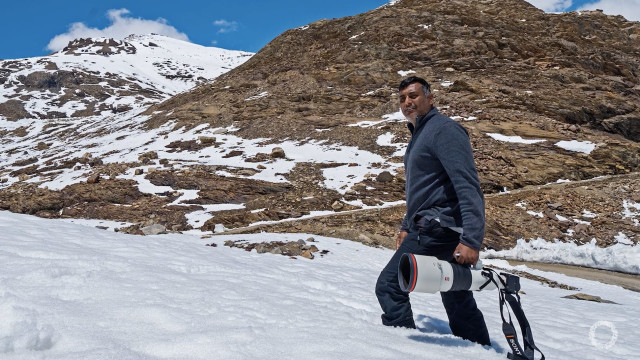How to Meditate for Beginners

Sometimes I feel like a failed meditator. It's not that I'm not trying, but I'm restless. My mind wanders. Seven minutes into mentally writing my grocery list, I remember I'm supposed to be focusing on my breath. It's as though the moment I sit down and close my eyes, every single thing on my to-do list needs to be done now.
Stumbling blocks like these are common for beginner meditators, but trying to push past them is well worth it. The research-based benefits of a regular meditation practice include better sleep, less stress, and more joy — all from simply focusing your attention inward. According to those who have been practicing meditation for years, the best way to begin a successful meditation practice is by letting go of what you think meditation is, what you believe meditating looks like, and how you measure whether you're doing it "right."
What Is Meditation?
Roundglass mindfulness teacher Vishvapani Blomfield has meditated for over 40 years and is a member of the Triratna Buddhist Order. He explains that although we often use the terms interchangeably, there is a difference between meditation, meditative states, and mindfulness.
"A meditation practice is a mental activity you do for a period of time that cultivates a state of mind that is more settled and absorbed. There's usually a focus for your attention, an object of meditation," he explains. The object of meditation can be something you're doing (like breathing or chanting a mantra), something you're picturing (like visualization imagery), or a broader thought practice or concept (like loving-kindness or Tonglen.)
Blomfield says that mindfulness is a bit different — it's simply the capacity to be aware. "It requires an element of calm, but you can be aware at any time, not just when you're meditating. Some meditation practices emphasize developing calm and absorbed meditative states. Some practices, which we call mindfulness meditation, are about developing broad awareness."
It's essential to learn what meditation is, but I discovered that it's also necessary to understand what it isn't because having the right approach is key to setting yourself up for success.
How to Be Good at Meditation
Many beginner meditators want to learn how to meditate and how to get good at meditation. It's natural to approach meditation with the same attitude you would learn any other new skill. Still, meditation teachers explain that focusing on a specific achievement or outcome can be counterproductive.
Roundglass meditation teacher Almeiri Santos explains that there's a reason meditation is referred to as a practice. "You don't get good at this!" she laughs when I ask how she mastered meditation. "Look, most people aren't going to sit down and have an empty mind for twenty minutes. Your mind is going to think. That's its job!"
Santos explains that my experience of feeling restless and distracted is common, and when meditating, it's natural for your mind to offer resistance and distraction. She says that rather than taking these thoughts and feelings as a sign of failure, you can anticipate them, acknowledge them, and then move beyond them.
How to Meditate with a Busy Mind
"I wish someone had told me that when I first started," she says. "When those thoughts come up, you don't have to listen to them. You can recognize, 'Oh wow, my mind sure is busy today!' and then return to your breath." Choosing to finish your meditation despite a busy mind is part of the process of developing focus.
Blomfield agrees, "I sometimes say this when I teach: You don't have to be perfect to meditate. Meditation is about being imperfect. If you sit there and your head is full of all sorts of thoughts, and you can't meditate longer than a flea, you know, that's all excellent. Because what it means is that you're a human being. Human minds don't just stop."
Seeking to have a mind empty of all thoughts and distractions is not only unrealistic, but it's also a misrepresentation of meditation's purpose. David Vago, Ph.D., cognitive neuroscientist and research lead at Roundglass, explains that while many people believe meditation is about creating an empty or relaxed mind, the truth is quite different.
"When you are sitting on a cushion with your eyes closed, the goal is not to be relaxed," he says. "You want to have a balance between some relaxation in the body but keeping your mind aware, sharp, and aroused." Meditation, he says, is about training the mind to become focused rather than relaxed.
So, it turns out I'm not a failed meditator after all. I'm just human. Here are five ways to embrace that imperfection and get started with that in mind.
How to Meditate in 5 Simple Steps
1. Start with an Open Heart.
Santos says that it's essential to begin your meditation practice with an open heart, offering yourself patience as you try something new and embracing the possibility that your path to meditation may look (and feel) different than you expect. She describes a friend who had immense difficulty meditating. "I said to him, 'Maybe we start by taking six breaths together, and we call that a meditation.'"
Begin your practice by meditating for just five or ten minutes a day and focus on simply showing up and creating a consistent habit. Doing so can also help you let go of the ego-driven need to meditate the most or meditate "right."
2. Create a Meditation Space
Although you don't have to dedicate an entire room to meditation, having a regular spot in which to meditate can be helpful to honor your budding practice and give your brain an association between the external environment and the internal state you're trying to cultivate.
"It's good to think about creating an environment that's going to be supportive. That can be as simple or as elaborate as you wish," says Blomfield. "It might be just that when you're sitting in your bedroom, you create a corner of the room that's tidy, or maybe you have a vase of flowers or an image of something that you find attractive or inspiring. I think for people who are beginning, it is good to create a sense of this ritual space."
3. Learn How to Sit for Meditation
Most meditation imagery shows a person sitting cross-legged or in a lotus pose, but you don't have to sit cross-legged to meditate. When Blomfield describes meditating for the first time at his local Buddhist center as a young teen, he remembers both the sense of awe he felt at discovering the untapped capacity of his mind and the pain in his knees from sitting cross-legged.
"I'm not very flexible, I don't have flexible hips, and even when I was 14, I didn't have flexible hips," he explains. Blomfield now meditates in a kneeling posture and advises others to find a position that works for them. "There's not much merit, in my view, in sitting uncomfortably. You want to be reasonably comfortable, but your body should also be awake and alert."
Why is it so important to be alert during meditation? In his course, Introduction to Mindfulness, mindful education consultant and Roundglass meditation teacher Curtis Smith says your posture is your body's way of communicating.
"We want to communicate to the universe and to our energy that we're ready to receive," he says. "You want to be sitting up... and in the position of attention. If you're slouching or leaning to the side, that's not a good look. That's not allowing you to set yourself up to be in the best condition for this practice."
Try this Roundglass meditation course: A Modern Guide to Mindfulness with expert Curtis Smith.
To find this balance between alert and comfortable, Blomfield recommends sitting in a kitchen chair – something that will keep your body supported and upright but won't encourage dozing off like a comfy armchair or a bed might.
4. Choose a Meditation Style
It can feel overwhelming to find a meditation style that's right for you while also developing the habit of meditation itself, so consider exploring guided meditations.
Accessing a library of guided meditations in different types and styles like visualization, mantra, chakra, or mindfulness meditations, including body scan, focused attention, insight, or noting and labeling practices, will help you experience a variety of approaches while also having the support of a teacher to help guide you through the practice.
You can try something new each day or repeat the same meditation several days in a row to deepen your experience; it's up to you!
Best of all, guided meditations allow you to experience meditation styles you may have never encountered otherwise, like this class, Spark Vibrant Energy.
Try this Roundglass meditation class: Find Your Unique Frequency with expert Maraliz Campos
5. Honor Your Practice
As a last piece of advice, Santos reminds her students to honor their practice. "I always tell my students that if they set a timer for five minutes, they stay on the cushion until they hear that timer," she says.
Doing so is a way of honoring the intention you set with yourself at the beginning of your practice, whether that intention was to meditate for five minutes or thirty. It may also help you stick it through the trickier parts of meditating as a beginner.
Taking a meditation course can help you honor your practice, ensuring that you show up for yourself day after day while being taught by an experienced meditation teacher.
Or, pair up with a friend and challenge yourselves to attend a mini meditation each day for seven, 14, or even 21 days in a row.
Above all, remember that there's no way to fail at meditation! Start small, anticipate resistance and distraction, and support your practice with your environment, your posture, and the wisdom of skilled meditation teachers.
Key Takeaways:
- Bring an open mind to your meditation practice.
- Create a dedicated space for meditation.
- Find a comfortable pose for your practice.
- Choose a style of meditation, then experiment until you find the best fit.
- Dedicate time to your practice.









